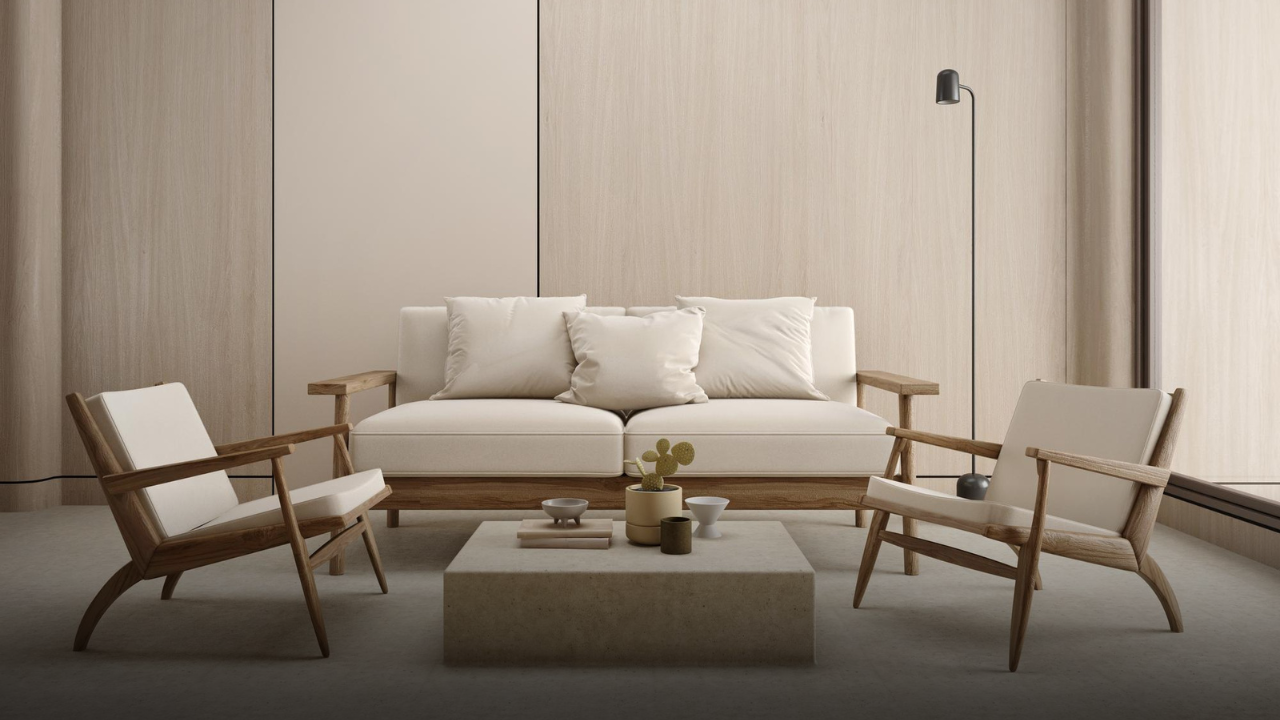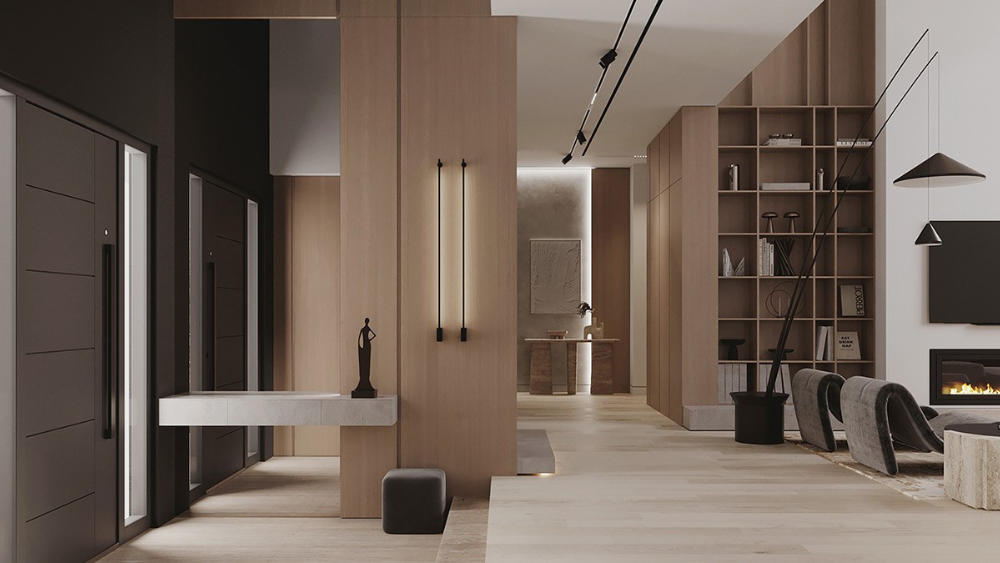Cozy Scandinavian decor meets the calming Japanese style in one of the most loved hybrid designs of the world: Japandi! The Japandi interior design style captures warm minimalism in the interior—creating a simple yet inviting living space. Keep reading to learn what the Japandi style is and how to decorate a Japandi living room. Also, keep an eye out for links to Japandi-inspired products to add to your space 🤍
What is the Japandi Interior Design Style?
The Japandi interior design is a fusion of the Japanese and Scandinavian interior design styles. Coincidentally, both styles have plenty in common. They’re simple in design and focus on a minimalist color palette. Plus, people in both Japan and Scandinavia absolutely love nature—and enjoy bringing it to their interiors.

The two styles also have their fair share of differences: Japanese design is influenced by Japanese principles, such as wabi-sabi, while Scandinavian design focuses on the principles of Nordic countries. Additionally, the former uses traditional textiles (such as tatami mats), while the latter prefers simple and geometric patterns.
The balance between the two design styles makes it easy (and incredibly fun!) to combine them. And while you can turn any room into Japandi with ease, we love this hybrid style in the living room. Keep reading to learn how!
Top 14 Ways to Decorate a Japandi Living Room

Embrace Simplicity
At the core of Japandi design is simplicity. So, for every design choice you make in the interior, be sure to keep simple forms in mind. From simple furniture choices to neutral color palettes, each Japandi design decision is driven by minimalism.

Update the Lighting Fixtures
Japandi lighting fixtures reflect the serene yet cozy vibe of the style. Skip the chandelier and consider a modern, organically-shaped ceiling light instead. If you have an open-floor plan, a multiple-light fixture would be great over the dining area. Make a statement in lighting by complementing layering these fixtures with your favorite Japandi-inspired floor lamps and pendant lights. Tip—if you’re creating a focal point with artwork, consider flanking it with Japandi wall sconces.

Add Plenty of Natural Materials
Both Japanese and Scandinavian designs celebrate the use of natural materials. Think elements like wood, bamboo, and stone to add warmth, as well as texture, to the space. Additionally, consider wooden furniture with a light finish (or bamboo accents) to infuse a natural touch. Another fun way to add rattan is with a room divider using the material.

Opt for Functional Furniture
The key to Japandi design is functional furniture. A minimalist sofa with a flowy shape sticks to the Japandi style in terms of design. Bonus points if it provides ample seating space according to the size of your family. Other Japandi furniture ideas are multifunctional pieces, such as those with hidden storage compartments.
Stick to Japandi Color Schemes
One thing instantly recognizable about Japandi style is its neutral color scheme. It embraces white, cream, grey, beige, and (surprisingly, yes) pastel reds as its main tones. Simultaneously, black and gold serve as contrasting colors. If you’d prefer to add more colors, lean towards muted blues, greens and browns. Tip—add color through accessories and keep the major furniture piece(s) neutral. This makes sure you can add color without straying away from the Japandi color scheme.
Consider Fluted Designs
Fluted designs are incredibly famous in Japandi living rooms. Comprising single, muted colors and clean lines, they can make a head-turning statement without overpowering the space. Especially so with a wooden slat wall, perfect to act as the accent wall of the living room. Other more subtle ways to achieve the purpose are ribbed side tables and lighting fixtures.

Embrace Color Contrasts with Wall Art
White and light rooms are Japandi’s favorite—but the style also welcomes bold contrasts of color! These add visual interest to the otherwise simple room and capture the eye without being overwhelming. A famous favorite is the classic black-and-white combination for wall art. Think a matte black fireplace or a set of black and beige wall decor. The latter is a great idea because you can switch it up as and when you wish.
Add Asian-Style Decor Elements
The secret to transforming a basic room into Japandi style? Asian-style decor elements! Add plenty of these to your living room for a space that truly feels Japandi. For example, consider Shoji screens as room dividers and lay down tatami mats for extra texture. Koi art is another great Asian-inspired addition. Tip: Be sure to stick to neutral colors for these decor elements for a mature look.
Focus on Throws and Blankets
A Japandi living room should have plenty of spaces where you can feel comfortable. Achieve the purpose with comforting items, such as chunky knit blankets and plush Japandi pillows. Soft foot throws also add to the comfort of Japandi living rooms.
Mix Circles and Squares
While many people hesitate to merge the two shapes, we love mixing circles and squares for a stunning contrast in a Japandi living room. A fun way to achieve the purpose is by adding sofas with sharp right angles and topping these with circular cushions. The right angle incorporates a hint of discipline, while the rounded forms add a sense of movement.
Leverage Existing Architecture
If your living room has a lofted ceiling, use it to your advantage. Exposed wood framing—in any form—can make outstanding natural decor additions to the room. You may opt for furniture colors that blend with natural wood. Simultaneously, choose ceiling colors that tie the room together.
Keep it Airy
A sense of calm can be achieved in Japandi interiors by making the overall design airy. While light colors and natural light play a massive role in airy living spaces, you can further enhance this effect by using lightweight fabrics and minimal (read: multifunctional) furniture pieces.
Go Big on Sustainability
Japandi interiors appreciate sustainable choices. Firstly, natural materials make the style a tip-top green option. (This includes leveraging natural light to illuminate the space during the day). Beyond that, you can make eco-friendly choices by looking for antique finds from thrift stores and—if you’re in for a good DIY—breathing life into old furniture. Energy-efficient lighting and appliances are other sustainable choices.
Play Around with Decor Arrangements
Symmetry is not a priority in Japandi interiors, so you can play around with arranging decor. Mix different furniture pieces to create a more organic look. For example, pair a statement sofa seating with an accent chair. However, consider the visual weight of each item—and focus on balance above over-decorating. When in doubt, remember, Japandi says less is best!
Final Words
Familiarizing yourself with the key aspects of the Japandi design can help you recreate its look in any room of your space. The most important part, however, is following your heart—even if that means straying away from Japandi principles 😉
Once you’re done creating your Japandi living room, be sure to stick to its rule of sustainability. Reduce, reuse, and recycle when you can—and choose products with minimal packaging. Also, be mindful of waste when decluttering (and renovating) your space.
Looking for Japandi furniture items for your home? Browse through our collection of elegant yet simple furnishings and decor options 🤍



Leave a comment
This site is protected by hCaptcha and the hCaptcha Privacy Policy and Terms of Service apply.